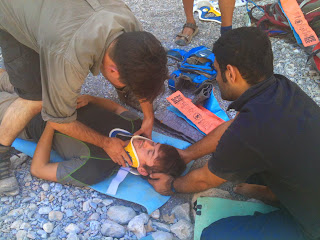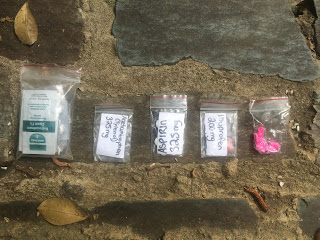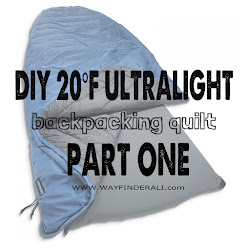I never go anywhere without a medical kit. After many years of traveling internationally, my kit is now both comprehensive and as efficient as possible. As a Wilderness First Responder, I do not want to get caught in an emergency without the basics like gloves, gauze and a Sam splint.
I want to make sure that I can properly care for myself and my companions. In this post I'll share with you what I bring and why.
The kit detailed in this post is for a group of around 4-6 people for up to a week-long trip.
The kit detailed in this post is for a group of around 4-6 people for up to a week-long trip.
Equip Your Mind: Knowledge is Paramount
 |
| Learning about spine stabilization during my Wilderness First Responder course in UAE |
The best kit is useless if you don't know how to use its contents.
A medical professional can often save a life by improvising with whatever is at hand. The best way to prepare for any kind of emergency is to ready yourself with knowledge and practice.
I recommend taking a Wilderness Advanced First Aid or Wilderness First Responder class before traveling. WAFA is a comprehensive course that gives you the tools and mindset you need to handle medical emergencies in any environment. If you're planning a water-based adventure, take a lifeguarding class in addition to WAFA. If WAFA is too expensive, consider the basic Wilderness First Aid course.
Wilderness Medical Organizations
 |
| Wilderness Medical Associates |
Pre-stocked Kits
I never buy pre-stocked kits because they are so pricey. I can stock a kit with what I want and need for much less money. A pre-stocked kit is a great starting point. It will equip you with the basics and is typically stocked based on trip size and duration which is incredibly helpful. If you choose this route, grab a pre-stocked kit that fits your trip size and duration, then customize it for your specific trip. For pre-stocked kits, I recommend the Adventure Medical Kit brand. They come in absolutely the best bags. The bag unfolds to create a work space and they are very durable. Stay away from Wal-Mart and Target kits because they are made for use in the front country where quality care is close by.
Things to consider when packing your kit:
- Group Size- More people = more problems. You will need more of everything. If someone has a high fever, you'll go through Tylenol (acetaminophen) very quickly.
- Trip Duration- longer trips mean more potential for sickness and injury
- Trip Location- Will you have access to quality health care where you are heading? How far removed from that medical care will you be? Are there lots of pharmacies where you can restock? It is a smart idea to bring broad spectrum antibiotics to third world countries where they may be hard to find or fake. Some people even bring their own IV kits to places where contaminated needles are prevalent.
- Planned activities- Going snorkeling? Bring tweezers and vinegar for sea urchins and jellyfish. Hikers need more moleskin and splinting supplies. Everyone heading to third world countries should bring extra re-hydration salts for food poisoning. High altitude trekkers should have detailed knowledge of altitude illness and stock their kit with Diamox
- Pre-existing conditions- Prone to motion sickness? Bring extra Dramamine. Pre-existing conditions often worsen during times of stress. Ensure all travelers have extras of their prescription medications. Plan ahead for dealing with flare ups of issues like heart conditions, joint injuries, and diabetes.
The Bag is Important
A good first aid bag is actually incredibly important. The bag should keep all the equipment organized, easy to find and access. Don't loose precious seconds searching for gloves or a CPR mask. Unfolding toiletry bags often make great first aid kits. Here is what I look for when buying a bag for a first aid kit:
- Opens to lay flat- This is so important. A bag that unzips to lay flat creates a work surface for you and eliminates digging to find what you need.
- Equipment specific pockets- Pockets designed to hold specific necessities will make finding what you need when you need it easier. I love the way that the Adventure Medical Kits bags have little clear pockets for each different kind of medication.
- Clear pockets- makes finding everything easy and fast
- Labeled Compartments- Anyone should be able to pick up a kit and easily find what they need. If your bag doesn't have labeled compartments, add them with fabric tape and a sharpie.
My Ultralight Bag
 |
| Monarch Ultralite Organizer by Equinox $23.43 on Amazon 1.6 oz, 6.5" x 9" x 2" |
I'm using the Monarch Ultralight Organizer by Equinox because it weighs 1.6 ounces and accommodates a full size Sam splint. The pockets are nearly perfect for all the things I need to organize, but I do wish there was a larger internal pocket. I'm currently keeping my larger pieces of gauze, Tagaderm and waterproof paper in the external pocket
Another great ultralight bag option is the Osprey Ultralight Zip Organizer which weighs 4oz and I think has better pockets but won't hold a Sam splint.
Bags Within Bags: Organizing Your Kit
 |
| A few of the medicines inside the bag |
 |
| Close up of the medication bag |
My Ultralight Kit Contents
CPR + Bleeding:
- CPR mask
- Powdered single dose Aspirin sachet
- Gloves x 3 pairs
- Tourniquet
- Combine pad
- Quick clot
Wound Care
- Assorted bandaids x 20 (I have lots)
- Tagaderm
- Non-stick gauze pads x 3
- Alcohol wipes x 4
- Beta-dine sachet x 2
- Burn gel sachet
- Roller gauze
Sprain / Break
- Ace bandage (also can be used as a trauma bandage)
- Sam splint
- Triangular bandage
Instruments and Equipment
- Trauma shears
- Tweezers
- Waterproof paper
- Sharpie
- Pen
- Pencil
- Duct tape
- Safety pins
- Lighter (optional)
- Thermometer
Medications
- Anaphylaxis: (not shown)
- Epinephrine vials
- Syringe and needles x 2
- Diphenhydramine (x4)
- Prednisone (only for extremely remote area)
- Pain / Fever
- Ibuprofen 200mg x 25
- Acetaminophen 500mg x 25
- Aspirin 325 mg x 15
- Naproxen Sodium x 10
- Dehydration / Stomach Upset / Motion Sickness
- Rehydration salts x 3
- Antacids x 2
- Loperamide x 10 (Immodium)
- Dimenhydrinate x 25 (Dramamine)
- Allergy + Cold
- Loratadine x 6
- Diphenhydramine x 6
- Psuedoephedrine x 4
- Antibiotics (Rx, extreme remote area only)
- Ciprofloxacin
- Azithromycin
- Amoxicillin
- Doxycycline
- Altitude Illness
- Acetazolamide (Diamox)
- Dexamethasone
Did you enjoy this post? Do you find my blog helpful? Now you can help me get the gear I need on my new Amazon List
Related Posts You Might Find Useful












